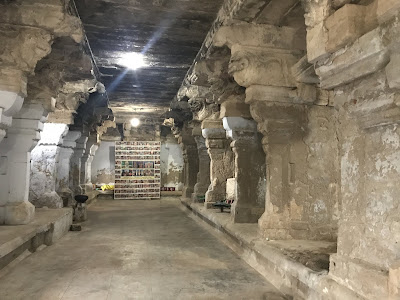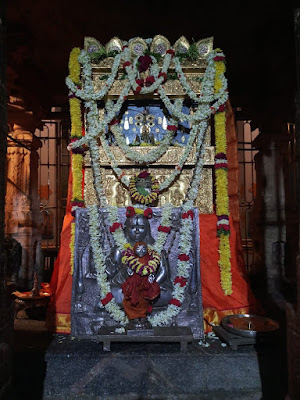It’s been over 3 weeks since I visited a temple. The longest in the last few years that I haven’t ever been to one for any reason. My love for visiting temples have at times preceded my devotion to the Deity. Rather, I would undertake trips to simply visit a temple rather than praying at that place. Such is the love and devotion that I have for a temple precinct. I get a sort of vibration when I visit temples, many of them. For Ex. When I am inside the Sanctum Sanctorum of our family deity at Parikkal – Sri Lakshmi Narasimha Swamy; inside the Tirumala Tirupati shrine; atop the holy Ahobilam Hills; closer home when I see Lord Sri. Parthasarathy or Goddess Karpagambal on close proximity and many such instances. I undergo a certain chemical reaction inside my brain and body which cannot be explained. And I am not the only one, for I know many who feel so when they visit their favourite temple.
Due to the ongoing Corona Virus lockdown, most of the temples have shut down for devotees and visitors across the world and India are no exception. Note, that the temples are closed for visitors and not to the Priests who perform their duties daily. It came as a shock when the most populated Hindu Temple on the basis of number of visitors everyday decided to close the doors – Tirumala Tirupati. An estimated 70,000 devotees throng the hill temple on an average day which peaks to 300,000 during festival periods such as Brahmotsavam. So, when the TTD authorities informed that the temple doors would be locked in tune with the nationwide 21-lockdown announced by the Union Government of India in March, many devotees were disturbed if the pandemic has reached disproportionate proportions. On 14 April, the PM extended the lockdown until 3 May 2020.
Most non-believers and many from other faiths mocked at Hindu temples, the culture ordained in our Sanathana Dharma and the very concept of “Idol Worship” calling it as “Idle Worship” since we devotees cannot even visit a temple, the most holy place for Hindus and purportedly the Lord within the confines of His & Her Sanctum Santorum is insecure to the extent that He / She cannot handle this pandemic and stop the spread. While there has been enough war of words on the social media and the internet space on this, I have personally refrained from explaining even once why our temples would remain important to us, during and after this Crisis.
Let me explain briefly here, my own limited understanding of why we visit Temples.
The Lord created this world and manifested Himself into various incarnations and forms. The first form is that of the Para-Rupa which can be seen at his eternal celestial abode – Sri Vaikuntam. He is seated there on the Adisesha, the snake along with his consort Mahalakshmi, Bhoo Devi & Neela Devi. Then He manifests in the Vyuha Rupa – on the Ksheerabdi where He is seen reclining on Adisesha on the divine Viraja River. Next is the Vibhava Rupa during which He manifests Himself in the form of various incarnations. Contrary to popular belief, the Lord doesn’t restrict himself to a mere 10 incarnations; rather his forms or manifestations are uncountable. Next, He resides inside every being which has been created by him in the form of Antaryaami, where the Paramatma resides next to the Jeevatma and guides the soul.
Lastly, in this Kali Yuga, the Lord manifests himself in a scripture – on stone or on the wood from a tree bark and is mostly seen in Temples which have been built over 1,000s of years ago by various people, mostly Kings and Emperors due to their wealth and largesse. At the end this Yuga, a Pralaya is expected, after which all creations would be wiped away – as per calculations, we are now 5,120 years young and we have another 426,000 years to complete this Kali Yuga. The Hindu Vedic Calendar doesn’t consist of 365 days, rather it differs based on movement of the Moon around the Sun.

Since we mortals cannot see how Lord Narasimha or Rama or Krishna existed in their respective Yugas of Krita, Treta or Dwapara, the Lord has manifested Himself in a particular form in this Yuga. Devotees throng to see the Lord in the respective temples in that particular form and not just to enjoy the beauty of the architecture, something that the Western World has pushed as an agenda even on believers of Sanathana Dharma. The external features are merely to showcase the artisanship of the artists and not necessarily to make the Lord or the Deity feel more superior. The Big Temple at Tanjore or the Bhooloka Vaikuntam at Srirangam are edifices to this aspect.
Therefore, we Hindus visit Temples not just to pray but to see the Lord (and the Goddesses) in various forms that He has manifested in. Each form has a reason and a meaning; they also accord blessings to devotees with a certain purpose. So, no form of the Lord is inferior to another which many devotees keep scrambling with their ideologies all the time claiming which Deity is more powerful or superior.
So, the Temples closing during the lockdown is not to protect Him, rather protect ourselves from spreading the viral infection to each other. As humans, we have withered away from following basic cleanliness measures which have been the basis of our Dharma. A bath before performing austerities, not touching one another’s food while eating and practicing highest levels of self-hygiene, more commonly known as “Madi-Acharam” in today’s times have become a joke during the past 100 years.

However, the West, WHO, all and sundry are imparting the public to follow the same steps that have been mentioned in our holy texts such as the Vedas and Upanishads on personal hygiene. What was once considered a taboo – washing one’s hands after touching another and a necessity such as washing hands before consuming food, have now become the most fashionable norm. A warm hug or a peck on the cheek are finally accepted as the fastest ways of transmitting viral infections, which has been the very basis of following isolation more popularly known as “staying Madi”. Once a son has been ordained “Yagnopaveetham”, even his mother is not allowed to feed him – the optimal age for this is 7 years, which is when medically it has been proven that kids start building their own immunity and bacteria. Many such things which have been well explained in our scriptures have been side-lined, thanks to the advent of various faiths which have unfortunately derogated our practices while eulogising theirs. Sad.
This lockdown period and self-quarantine is a blessing in disguise for us to look back at even some of our healthy practices which was followed by our grandparents, as late as the 1950s or 60s in India. Apart from praying at home – where many of our households adorn photos of deities of various forms, we also get time to chant our favourite slokas and mantras which we may know or would like to learn. A simple rendition of Sri Vishnu Sahasranamam which is said to encompass a thousand names of the Lord is good enough if at all one can spend 29 odd-minutes for ourselves once a day. This particular sloka is said to have various health benefits, including streamlining blood pressure to increasing memory. For me, personally this one sloka is an all-time favourite and one stop remedy, whether I am undergoing severe Migraine or sleeplessness, invariable stress or just to simply while away time.

Goddess Parvati asks during the rendition of the Sahasranamam, what is a faster way to finish saying a thousand names to which Lord Shiva replies – a mere chanting of “Sri Rama” is good enough.
So, this lockdown period, fret not that we are unable to visit temples or perform rituals. At least for another 4 lakh years, the Temples will remain and so would we. Yes, we will eventually die this birth only to be reborn again. And Again and again, something that has been very aptly propounded in Bhaja Govindam sloka by Sri Adi Sankaracharya – Punarapi Maranam, Punarapi Jananam. We are born to die to be born yet again. So, fret not for we shall visit our favourite temples again, soon. The Lord is eagerly awaiting for us to return so we can once again get ecstatic looking at His form on stone and wood.
This too shall pass by. Let’s pray for the Corona Crisis to end soon. My prayers are more so, that I can drive down to a Temple thereafter. Actually, I need a short vacation of a few weeks to visit some of my favourite temples across the Southern States. With the guidance of our beloved Gurus without whom we cannot reach the Almighty, we are eagerly awaiting the Lord’s grace to visit Him soon.














